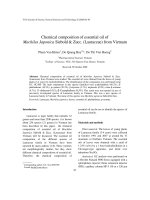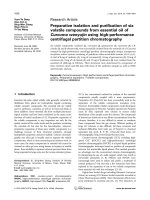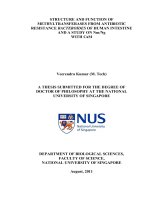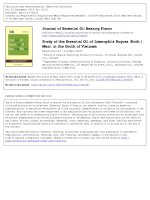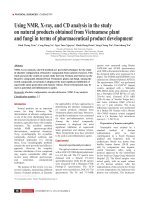Study on natural floor cleaner from some herbals
Bạn đang xem bản rút gọn của tài liệu. Xem và tải ngay bản đầy đủ của tài liệu tại đây (447.6 KB, 10 trang )
����������������������������������������������������������������������������������������������������������������������������������������������������������������������������������������������������������������������������������������������������������������������������������������������������������������������������������������������������������������������������������������������������������������������������������������������������������������������������������������������������������������������������������������������������������������������������������������������������������������������������������������������������������������������������������������������������������������������������������������������������������������������������������������������������������������������������������������������������������������������������������������������������������������������������������������������������������������������������������������������������������������������������������������������������������������������������������������������������������������������������������������������������������������������������������������������������������������������������������������������������������������������������������������������������������������������������������������������������������������������������������������������������������������������������������������������������������������������������������������������������������������������������������������������������������������������������������������������������������������������������������������������������������������������������������������������������������������������������������������������������������������������������������������������������������������������������������������������������������������������������������������������������������������������������������������������������������������������������������������������������������������������������������������������������������������������������������������������������������������������������������������������������������������������������������������������������������������������������������������������������������������������������������������������������������������������������������������������������������������������������������������������������������������������������������������������������������������������������������������������������������������������������������������������������������������������������������������������������������������������������������������������������������������������������������������������������������������������������������������������������������������������������������������������������������������������������������������������������������������������������������������������������������������������������������������������������������������������������������������������������������������������������������������������������������������������������������������������������������������������������������������������������������������������������������������������������������������������������������������������������������������������������������������������������������������������������������������������������������������������������������������������������������������������������������������������������������������������������������������������������������������������������������������������������������������������������������������������������������������������������������������������������������������������������������������������������������������������������������������������������������������������������������������������������������������������������������������������������������������������������������������������������������������������������������������������������������������������������������������������������������������������������������������������������������������������������������������������������������������������������������������������������������������������������������������������������������������������������������������������������������������������������������������������������������������������������������������������������������������������������������������������������������������������������������������������������������������������������������������������������������������������������������������������������������������������������������������������������������������������������������������������������������������������������������������������������������������������������������������������������������������������������������������������������������������������������������������������������������������������������������������������������������������������������������������������������������������������������������������������������������������������������������������������������������������������������������������������������������������������������������������������������������������������������������������������������������������������������������������������������������������������������������������������������������������������������������������������������������������������������������������������������������������������������������������������������������������������������������������������������������������������������������������������������������������������������������������������������������������������������������������������������������������������������������������������������������������������������������������������������������������������������������������������������������������������������������������������������������������������������������������������������������������������������������������������������������������������������������������������������������������������������������������������������������������������������������������������������������������������������������������������������������������������������������������������������������������������������������������������������������������������������������������������������������������������������������������������������������������������������������������������������������������������������������������������������������������������������������������������������������������������������������������������������������������������������������������������������������������������������������������������������������������������������������������������������������������������������������������������������������������������������������������������������������������������������������������������������������������������������������������������������������������������������������������������������������������������������������������������������������������������������������������������������������������������������������������������������������������������������������������������������������������������������������������������������������������������������������������������������������������������������������������������������������������������������������������������������������������������������������������������������������������������������������������������������������������������������������������������������������������������������������������������������������������������������������������������������������������������������������������������������������������������������������������������������������������������������������������������������������������������������������������������������������������������������������������������������������������������������������������������������������������������������������������������������������������������������������������������������������������������������������������������������������������������������������������������������������������������������������������������������������������������������������������������������������������������������������������������������������������������������������������������������������������������������������������������������������������������������������������������������������������������������������������������������������������������������������������������������������������������������������������������������������������������������������������������������������������������������������������������������������������������������������������������������������������������������������������������������������������������������������������������������������������������������������������������������������������������������������������������������������������������������������������������������������������������������������������������������������������������������������������������������������������������������������������������������������������������������������������������������������������������������������������������������������������������������������������������������������������������������������������������������������������������������������������������������������������������������������������������������������������������������������������������������������������������������������������������������������������������������������������������������������������������������������������������������������������������������������������������������������������������������������������������������������������������������������������������������������������������������������������������������������������������������������������������������������������������������������������������������������������������������������������������������������������������������������������������������������������������������������������������������������������������������������������������������������������������������������������������������������������������������������������������������������������������������������������������������������������������������������������������������������������������������������������������������������������������������������������������������������������������������������������������������������������������������������������������������������������������������������������������������������������������������������������������������������������������������������������������������������������������������������������������������������������������������������������������������������������������������������������������������������������������������������������������������������������������������������������������������������������������������������������������������������������������������������������������������������������������������������������������������������������������������������������������������������������������������������������������������������������������������������������������������������������������������������������������������������������������������������������������������������������������������������������������������������������������������������������������������������������������������������������������������������������������������������������������������������������������������������������������������������������������������������������������������������������������������������������������������������������������������������������������������������������������������������������������������������������������������������������������������������������������������������������������������������������������������������������������������������������������������������������������������������������������������������������������������������������������������������������������������������������������������������������������������������������������������������������������������������������������������������������������������������������������������������������������������������������������������������������������������������������������������������������������������������������������������������������������������������������������������������������������������������������������������������������������������������������������������������������������������������������������������������������������������������������������������������������������������������������������������������������������������������������������������������������������������������������������������������������������������������������������������������������������������������������������������������������������������������������������������������������������������������������������������������������������������������������������������������������������������������������������������������������������������������������������������������������������������������������������������������������������������������������������������������������������������������������������������������������������������������������������������������������������������������������������������������������������������������������������������������������������������������������������������������������������������������������������������������������������������������������������������������������������������������������������������������������������������������������������������������������������������������������������������������������������������������������������������������������������������������������������������������������������������������������������������������������������������������������������������������������������������������������������������������������������������������������������������������������������������������������������������������������������������������������������������������������������������������������������������������������������������������������������������������������������������������������������������������������������������������������������������������������������������������������������������������������������������������������������������������������������������������������������������������������������������������������������������������������������������������������������������������������������������������������������������������������������������������������������������������������������������������������������������������������������������������������������������������������������������������������������������������������������������������������������������������������������������������������������������������������������������������������������������������������������������������������������������������������������������������������������������������������������������������������������������������������������������������������������������������������������������������������������������������������������������������������������������������������������������������������������������������������������������������������������������������������������������������������������������������������������������������������������������������������������������������������������������������������������������������������������������������������������������������������������������������������������������������������������������������������������������������������������������������������������������������������������������������������������������������������������������������������������������������������������������������������������������������������������������������������������������������������������������������������������������������������������������������������������������������������������������������������������������������������������������������������������������������������������������������������������������������������������������������������������������������������������������������������������������������������������������������������������������������������������������������������������������������������������������������������������������������������������������������������������������������������������������������������������������������������������������������������������������������������������������������������������������������������������������������������������������������������������������������������������������������������������������������������������������������������������������������������������������������������������������������������������������������������������������������������������������������������������������������������������������������������������������������������������������������������nit
Test method
mg/kg ACM THA 05+
AOAC 2015.01
Metal Conc.
mg/kg TCVN 6971:2001
TCVN 12589:2018
Residue content, % g/ml ASTM D 1290
mass
Content
of
non- g/ml ASTM D 2834
volatile matter (total
solids), % by mass
pH
pH meter
Stability at 50oC for
8h
Results
Liquid,
homogeneous,
without
layering
or
precipitation at temperatures
below 20oC
Brown, clear
Characteristic scent
No detect (LOD = 0,1)
<2,0
0,035
6,5
No precipitation
4. CONCLUSION
Organic floor cleaner is synthesized from soapberry, cinnamon, lemongrass essential oil,
and coriander essential oil, which are ingredients of natural origin, containing active ingredients
capable of cleaning and scent. Fragrant, suitable for human health, such as saponins, cinnamic
aldehydes, citral, and geraniol. The optimal ratio for floor cleaning water is: 1L of floor cleaning
solution including 300ml soapberry: 300ml essential oil: 380ml distilled water: 10ml Glycerol:
5ml coriander essential oil: 5ml lemongrass essential oil.
Natural floor cleaner with ingredients of natural origin does not contain harmful chemicals,
does not cause skin irritation or some respiratory diseases, and is safe for users, especially
children. The scent of organic floor cleaner comes from natural ingredients and aromatic
essential oils; although not durable over time, it is entirely non-toxic and suitable for human
health. In addition, compounds in organic floor cleaning water, when discharged into the
environment, are easy to decompose, causing no pollution to water sources and the
environment.
104
HANOI METROPOLITAN UNIVERSITY
REFERENCES
1. Do Tat Loi (2004), Vietnamese medicinal plants and herbs, Times Publishing House.
2. Thai Doan Tinh, Vu Quoc Trung (2005), Experimental organic chemistry, Vietnam Education
Publishing House.
3. Le Thi Anh Dao, Dang Van Lieu (2010), Practice organic chemistry, Pedagogical University
Publishing House, 2010
4. Duong Tan Nhut (2011), Plant biotechnology: Basic and applied research, Agriculture Publishing House.
5. Nguyen Minh Thao (2014), Organic synthesis, Hanoi National University Publishing House.
6. Nguyen Van Han (2015), Medicinal Extraction Technique, Medicine Publishing House.
7. A.T Soldatenkov, N.M Kolyadina, Le Tuan Anh (2017), Applied Organic Chemistry, Knowledge
Publishing House.
8. TCVN 12589:2018, Floor cleaner – technical requirements and test methods
9. TCVN 6971:2001, Synthetic washing water for the kitchen.
NGHIÊN CỨU TỔNG HỢP NƯỚC LAU SÀN HỮU CƠ
TỪ MỘT SỐ LOẠI THẢO DƯỢC THIÊN NHIÊN
Tóm tắt: Nghiên cứu trình bày quy trình tổng hợp nước lau sàn hữu cơ từ cao bồ hòn, tinh dầu
quế, tinh dầu mùi già và tinh dầu sả chanh. Các tỷ lệ tổng hợp khác nhau được đưa ra và khảo
sát qua ý kiến người sử dụng để đưa ra tỷ lệ tối ưu. Sản phẩm nước lau sàn hữu cơ đạt được tiêu
chí sạch, sát khuẩn, khơng bám dính và mùi hương nhẹ lưu lau ở tỷ lệ 1L dung dịch lau sàn bao
gồm: 300ml dd cao bồ hòn: 300ml dd vỏ quế: 380ml nước cất: 10ml Glycerol: 5ml tinh dầu Mùi
già: 5ml tinh dầu sả chanh. Mẫu nước lau sàn tối ưu đã được phân tích theo Tiêu Chuẩn Việt
Nam (TCVN) 12589:2018, Nước lau sàn – yêu cầu kỹ thuật và phương pháp thử
Từ khóa: Nước lau sàn, cao bồ hòn, tinh dầu quế, tinh dầu mùi già và tinh dầu sả chanh
